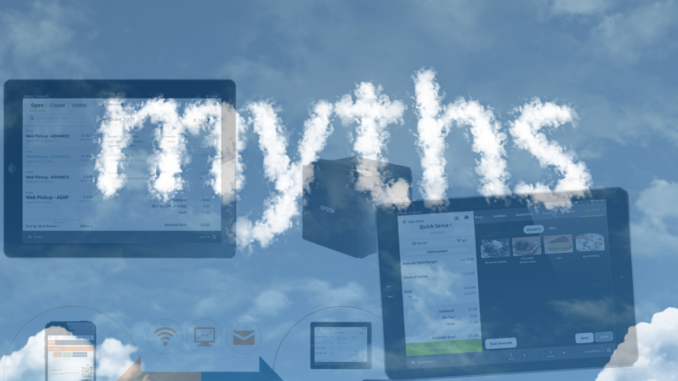
By Saleem S. Khatri, CEO of Lavu and MenuDrive - 5.10.2020
Now more than ever, technology is an essential part of restaurant operations as it substitutes for human interaction. In the face of a public health crisis, technology has become a necessity, helping restaurants stay open. Restaurants need to find ways to maintain efficiency, improve customer service, and ensure employees are safe and happy.
Technology can assist in all those areas. In fact, 95 percent of restaurateurs agree that restaurant technology improves their business efficiency. Implementing automation into your restaurant operations helps the most vital aspects of your restaurant work in a streamlined and well-organized way.
Despite the prevalence of technology across the restaurant landscape, many misconceptions about its effectiveness still persist. Here are four common restaurant technology myths that have cemented themselves in the minds of many restaurateurs, along with the truth about how modern, restaurant technology systems can benefit restaurant owners, especially in today’s climate.
Restaurant technology takes away jobs
Implementing technology to manage restaurant operations isn’t anything new. Investing in software that oversees inventory, finances, employee schedules and more has become a norm for restaurant operators. In regards to the well-known myth that restaurant technology takes away jobs, utilizing software for your restaurant can actually create jobs and improve employee morale. A perfect example is online ordering software.
In light of the current restaurant shutdowns, having an online ordering option is a necessity. This still requires staff to prepare orders and interact with customers during pick up, in fact, online ordering increases the number of orders a restaurant receives when compared to phone calls or walk-ins alone. Human interaction within the service-based industry can never be replaced as it is the foundation of the customer experience. This will not go away as restaurants recover from this pandemic. Right now, technology is helping to ensure employees have jobs to come back to when restaurants open up again.
Restaurant technology is susceptible to hacking and data breaches
As more business has to be conducted online, there is going to be an increase in data available. But the risk of security and data breaches depends entirely on the software and systems in use. Restaurants should only use PCI-compliant hardware and processors that have thoroughly encrypted credit card readers.
To help prevent fraud attacks, restaurants need to ensure they comply with the standards governing the handling of payment card information, are able to manage the risks associated with vendors, and have an effective response plan in place in case a breach does occur. New technologies like automation, AI and POS software ensure private data is better protected from online criminals. Using the right software to handle your data will minimize risks to customer data, add less friction to the customer journey and cover early fraud pain points along the way to check out.
Restaurant staff needs to be tech-savvy to use technology
Many restaurant tech platforms and apps have been designed for intuitive, easy use, regardless of how much tech experience the staff has. For example, POS software requires little to no IT knowledge. It enables minimal training time for employees because they are utilizing technology they are already familiar with such as iPhones, iPads or tablets. It’s a very convenient tool for small or large restaurants to use and improves efficiency in both front-of-house and back-of-house operations.
Many restaurants are adapting to being delivery and take-out only, which can often mean learning new systems. Having an online ordering system does not have to be complex. Your business can be set up and ready to go quickly with the right tool.
All restaurants need their own apps
Single-location restaurants may not experience a strong return on investment from developing apps. Apps can provide a great customer experience which chain QSR and fast-casual restaurants can benefit greatly from. But, the cost of these apps can outweigh the benefits for smaller operations.
Luckily, there are other options. A white-labeled online ordering platform provides restaurants with their own personalized online storefront and built-in marketing tools like loyalty programs and email capabilities. This allows restaurants to provide seamless service to customers without the inhibiting cost of an app.
The current climate has further proven the need for technology in the restaurant industry. Investing in technology can be difficult, but the benefits are evident. Technology will play a vital role in ensuring the restaurant industry survives this public health crisis. If you’re a restaurateur looking to step up your tech game, now is the time.
 Saleem S. Khatri is the CEO of Lavu and MenuDrive, a restaurant management platform and white-labeled online ordering platform. Prior to Lavu, Saleem successfully built software and hardware companies at start-ups via Y Combinator and other investment firms. Additionally, Saleem was appointed to manage a $79 billion investment portfolio on behalf of the United States Department of the Treasury. Saleem earned his MBA from the Harvard Business School. MenuDrive is the world’s first white-labeled online ordering solution that combines online ordering, delivery, marketing tools, and analytics at no upfront cost to the restaurant operator. Lavu’s other products include an award-winning mobile point-of-sale, payment processing, and back of the house software. Used in food service establishments in more than 98 countries, Lavu and MenuDrive offer flexible payment-processing solutions, a proprietary business management suite, and unbeatable online ordering ideal for all food and drink establishments.
Saleem S. Khatri is the CEO of Lavu and MenuDrive, a restaurant management platform and white-labeled online ordering platform. Prior to Lavu, Saleem successfully built software and hardware companies at start-ups via Y Combinator and other investment firms. Additionally, Saleem was appointed to manage a $79 billion investment portfolio on behalf of the United States Department of the Treasury. Saleem earned his MBA from the Harvard Business School. MenuDrive is the world’s first white-labeled online ordering solution that combines online ordering, delivery, marketing tools, and analytics at no upfront cost to the restaurant operator. Lavu’s other products include an award-winning mobile point-of-sale, payment processing, and back of the house software. Used in food service establishments in more than 98 countries, Lavu and MenuDrive offer flexible payment-processing solutions, a proprietary business management suite, and unbeatable online ordering ideal for all food and drink establishments.
Are you an industry thought leader with a point of view on restaurant technology that you would like to share with our readers? If so, we invite you to review our editorial guidelines and submit your article for publishing consideration.

